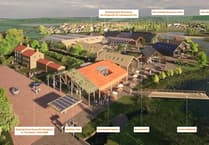CONTROL of wild boar numbers in the Forest could depend on more action by private landowners as well as the Forestry Commission, say experts.
The latest survey of boar shows the spread of the animals is increasing some three to four times more quickly than the density.
The number of wild boar has nearly doubled in two years despite a cull of 361 animals last year.
The annual thermal imaging survey the Forestry Commission carried out on its land arrived at a figure of 1,018 animals compared with 819 last year and 535 in 2013.
The figure of 1,018 comes with a confidence level of 95 per cent, meaning the actual number of boar in the Forest could be between 696 and 1,486, according to researchers.
Looking at the rate of distribution, Roger Gill and Mark Ferryman of Forest Research concluded: "If this trend continues, the management of the population will become increasingly dependent on whatever control efforts are being applied outside the public forest estate."
Their report was presented to the Forest Council's strategic overview and scrutiny committee by Deputy Surveyor for the Forest, Kevin Stannard.
He said: "The population is going up and we are going to put some additional resources to try and stop that upward trajectory this autumn and then endeavour to bring the population back down to the target of 400 animals.
"We increased the resources last year by 25 per cent and more than doubled the cull as a result so we aim to do the same again and increase the number of wildlife rangers to do the culling.
He said wildlife rangers who carried out the cull had done a 'sterling job' in achieving 361 because one of them was new and was 'learning the ground' and because of disruption by anti-cull campaigners.
Last year the group Sab the Wild Boar Cull promised to disrupt the cull and a post on its Facebook page has said it will repeat its activities when this year's cull gets underway in the autumn.
Mr Stannard said: "There is certainly no consensus on whether we should be culling at all – we've had to take a gently, gently, step-by-step approach.
"Now we have three years' scientific evidence of what the population is doing supported by the thermal imaging survey.
"We've got the evidence of what the reproductive rates are, we've got the evidence of the densities.
"When we undertake the thermal imaging survey next year, if we've got it right, will be reporting about 1,000 in the Forest again.
"With that confidence we can then set a figure to start bringing it back down but it is very difficult to do these things in the face of sustained opposition without the scientific evidence that we have now painstakingly put together over the last three years."
He also claimed there had been 'significant' amounts of abuse and intimidation of rangers by anti-cull activists.
-----
Where are the boar?
THE AREA of the Forest where boar are living is getting larger every year, says the Forestry Commission.
The number of 100-hectare squares used as a base by experts in which boar were detected by the annual survey of Forestry Commission has risen from six in 2008 to 30 in 2014 and 43 this year.
The survey found 76 sounders, or family groups, although the average size of each group was lower at 3.33 than last year when it was 4.49.
Deputy Surveyor of the Forest, Kevin Stannard, told Forest councillors the animals were "highly mobile" and did not stick to a territory.
The survey arrived at a figure of 1,018 boar compared with 819 last year.
The largest number of boar was found in High Meadow, between Coleford and Monmouth, where there were 351 animals detected, an increase of 48.
The next highest concentration was at Serridge-Crabtree near Cinderford which had 135, an increase of 81.
The largest drop in numbers was at Kensley, near Cinderford where seven boar were detected this year compared with 201, a decrease of 194.
According to a report for the Commission, a cull of 460 animals would be needed to stabilise the population and the stop the upward trajectory of numbers.
Mr Stannard presented the report to the Forest Council's strategic overview and scrutiny.
He was asked what the Commission's liability would be if somebody was injured by a boar.
Mr Stannard said the Commission could not be held liable because boar are classified as wild animals – and there had been no direct reports of people being injured by boar.
He added: "Feral wild boar are defined as a wild animal and nobody is responsible for the actions of wild animals.
"We have had no direct reports of members of the public being directly injured as a result of feral wild boar activity on the public forest estate.
"There have been significant reports of dogs being attacked by boar and of dogs attacking boar."




